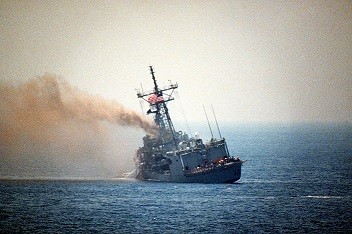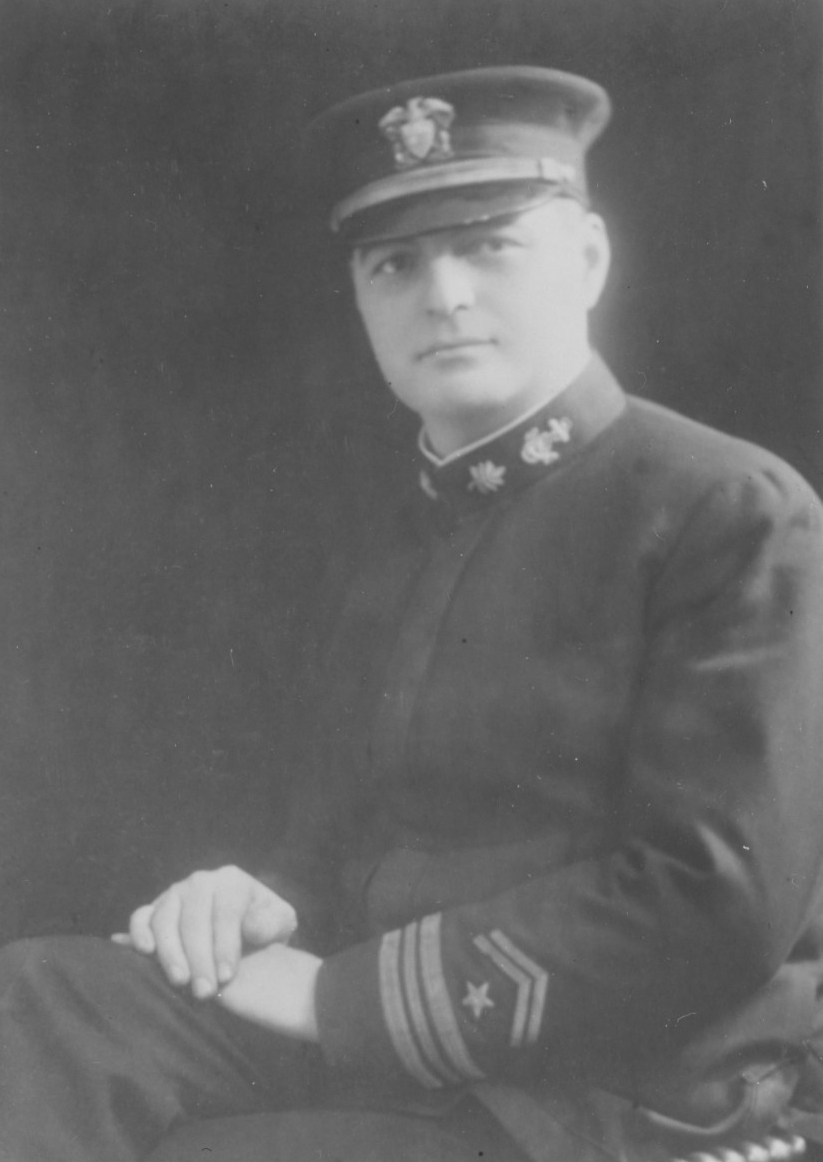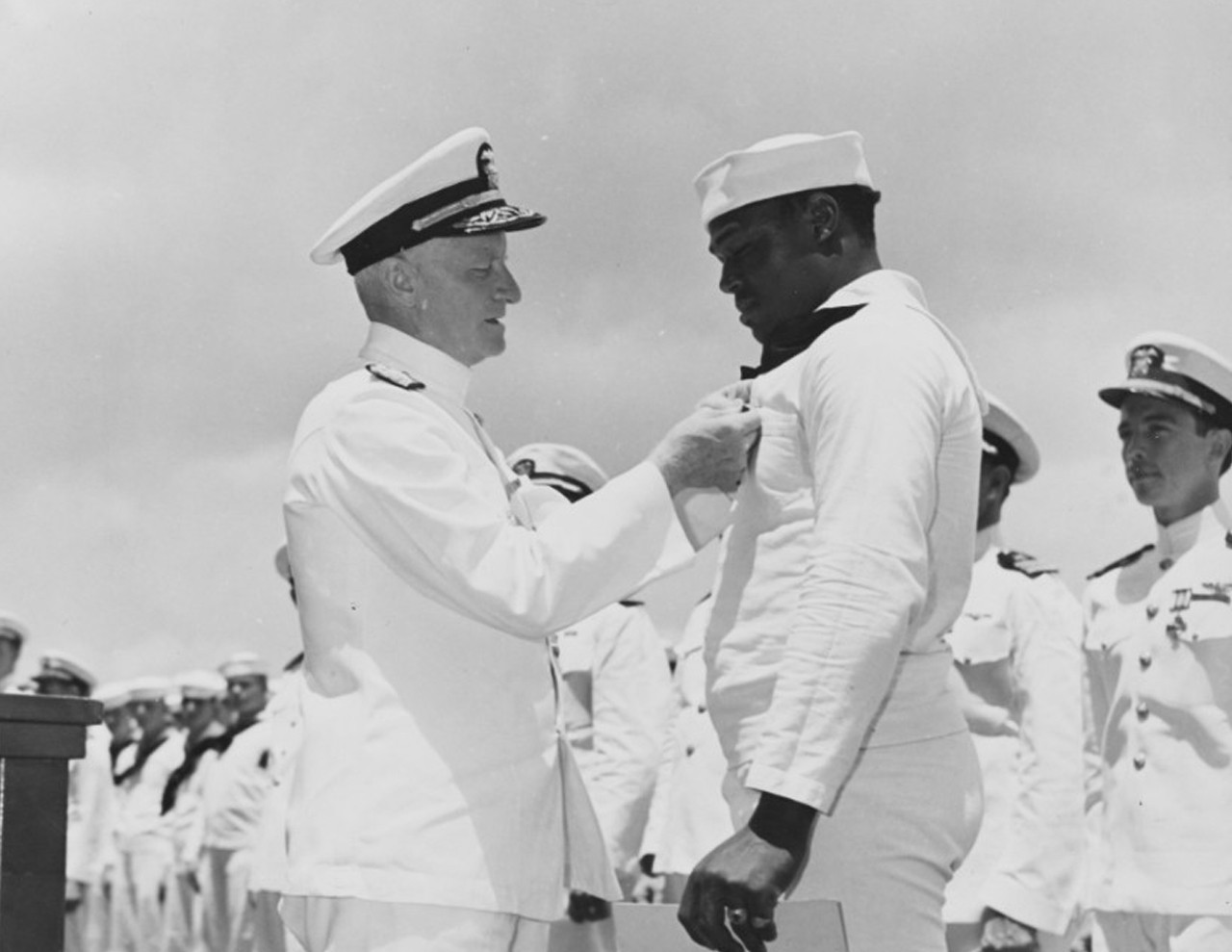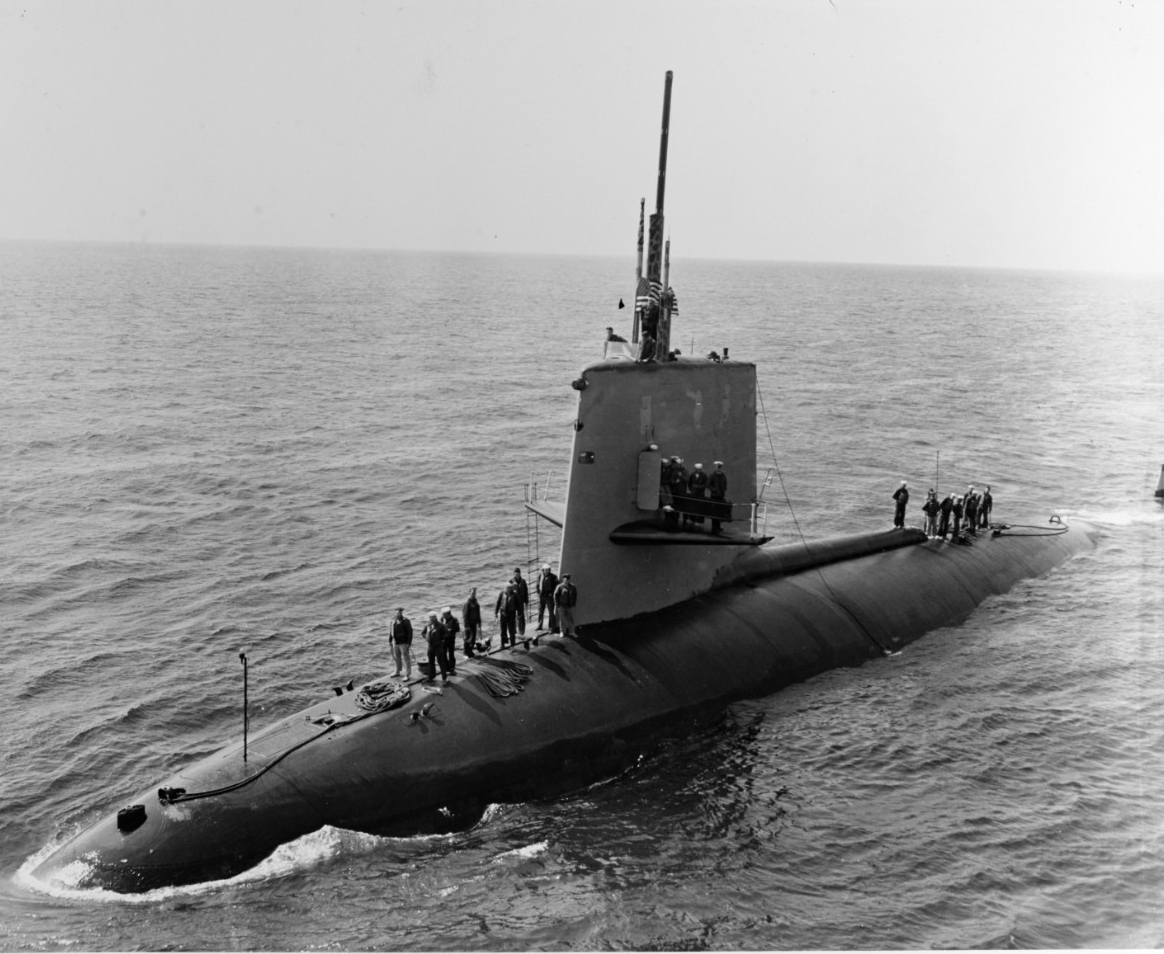Compiled by Brent Hunt and Wendy Arevalo, Naval History and Heritage Command Communication and Outreach Division.

USS Stark (FFG-31) listing the day after two Iraqi air-to-ground missiles struck her port side in the Persian Gulf, May 18, 1987.
Today in Naval History
On May 17, 1987, 35 years ago, USS Stark (FFG-31), home-ported in Mayport, Florida, was struck by two Iraqi Exocet air-to-ground missiles while on patrol in the Persian Gulf. The attack killed 37 American Sailors and wounded another 21. It was the deadliest assault on a U.S. Navy ship since the Vietnam War. Stark was off the Saudi Arabian coast near the Iran-Iraq war exclusion boundary when it was hit. The first missile slammed into the port side of the ship, nearly 13 feet above the waterline, but did not detonate. It severed the firefighting water lines to the forward part of the ship and caused volatile fuel to leak. About 25 seconds later, a second missile hit a few feet aft of the same location and exploded, with the fuel from the first missile feeding the detonation of the second. The shock of the hits tore fixtures from bulkheads and wrecked equipment. Heat from the fires and blinding smoke initially impeded damage control efforts, and flames melted the aluminum superstructure and decks.
Lt. William A. Conklin, the ship’s damage control assistant at the time, had just completed a long day of watches and was settled into his rack for some much-anticipated sleep when the first missile struck. Conklin leaped to his feet and quickly donned his coveralls as the bridge passed a chilling order over the intercom: “Inbound missile, port side, all hands brace for shock.” The second Exocet struck the ship, and the lieutenant raced to his battle station in Damage Control Central, where he learned to his horror that the attacks all but neutralized the firefighting system. The blaze reached extreme temperatures and threatened the ship, so Conklin and Hull Maintenance Technician 1st Class Michael J. O’Keefe crawled through the fire despite agonizing pain from the heat and closed the critical fire main valves, isolating the torn pipes. “It was a fight for survival,” O’Keefe later said. “I was fighting to stay alive.” The blaze engulfed berthing spaces, the ship’s store, post office, and barber shop. Crewmen used a P-250 pump to provide water to battle the flames in the forward section of the ship, supplementing their efforts with electric submersible pumps. Sailors felt heat rising from the deck into their feet, but continued to direct water onto the flames, only to discover that the heat turned the water into scalding steam. The crew sprayed so much water onto the ship that it listed up to 17 degrees to port from the weight.
The attack also severed some of the ship’s communications, so the firefighters rigged a “salt and pepper” line with sound powered phones between the bridge, aft steering, and the flight deck in order to direct damage control efforts. Crewmembers also threw missiles and .50-caliber rounds overboard to prevent them from exploding. The crew used so many oxygen breathing apparatus canisters that they ran out, which brought their firefighting efforts to a halt. USS Waddell (DDG-24) and other ships in the vicinity brought them additional canisters within the hour. Firefighting teams from the other ships also rotated through, relieving Stark’s exhausted crewmen. The thick black smoke blocked emergency lighting and plunged compartments below deck into total darkness, but the crew used flood lanterns to illuminate some of the darkened compartments and passageways. In addition, live electrical wires torn from their housings burned some members of the crew. The attack destroyed the ladder ascending to the next deck, and as some of the crew ran out of air, they had to choose between the raging fires or jumping in the sea. Some jumped out of the very hole torn by the impact of the missile strikes. A lookout tossed them life rings as Stark moved on. They survived until the next morning despite recollections of spotting sharks.
Eventually, Stark’s crew and other personnel from the ships in the vicinity saved the ship. Iraq, which at the time was a U.S. ally, apologized for the attack. They claimed the pilot involved mistook Stark for an Iranian tanker. The attack incensed many Americans, and Sixth Fleet alerted USS Kitty Hawk (CV-63)—already deployed to the Mediterranean—to stay in the area for possible retaliatory strikes against the Iraqis, but the carrier subsequently moved on. “I know and I share,” President Ronald W. Reagan said the next day, “the sense of concern and anger that Americans feel over yesterday’s tragedy in the Persian Gulf…. The officers and crew of USS Stark deserve our highest admiration and appreciation.” Stark returned home to Mayport for a hero’s welcome and later returned to service in August 1988.
The Heroism of Ensign Daniel A.J. Sullivan
On May 21, 1918, during World War I, Ensign Daniel A.J. Sullivan, while serving on Christabel (S.P.-162), exhibited “extraordinary heroism” when, in combat action against a German U-boat, secured several live depth charges that had come loose on the ship. He managed to fall onto the rolling charges and secure them, “thus saving the ship from disaster, which would inevitably have caused great loss of life.” For his actions, he received the Medal of Honor. On that day, Christabel was escorting a slow ship, which had dropped behind the northbound convoy from La Pallice, France, to Quiberon Bay. The vessel, British steamer Danae, was about eight miles behind the convoy, making about seven and a half knots, with Christabel on its port bow. The sea was smooth, the weather clear with no wind. When the converted yacht reached a position about two miles outside of Ile de Yeu, a lookout sighted a well-defined oil slick on the port bow. Christabel cruised around it, but saw nothing definite. At 5:20 p.m., the officer of the deck and the lookout suddenly sighted a wake about 600 yards off the port quarter. Christabel, at the time, was about 300 yards off Danae’s port bow. The yacht headed for it, but once there, the wake disappeared.
Lt. Millington B. McComb, Christabel’s commanding officer, followed the oil as well as he could, and at 5:24 p.m., believing that his ship steamed ahead of the enemy submarine, dropped a depth charge. Although the charge exploded, no results were obtained. At 7 p.m., the convoy changed course, following the contour of the land, at about nine knots. Christabel patrolled astern, making about 11 knots to catch up. At 8:52 p.m., Christabel’s crew sighted a periscope about 200 yards off the starboard beam. The yacht turned and headed for it, whereupon the periscope disappeared. At 8:55 p.m., she dropped a depth charge, which exploded about 10 seconds later, followed by a second depth charge a few moments afterward. Nothing followed the explosion of the first charge, but following the explosion of the second, a third and very violent explosion shot skyward between Christabel’s stern and the water column raised by the second charge. Christabel then turned and cruised the vicinity and noticed a quantity of heavy black oil and splintered pieces of wood, with very large oil bubbles rising to the surface. It was later determined that the submarine engaged by Christabel was UC-56. The enemy submarine wasn’t sunk, but was so heavily damaged from the encounter that it was unable to return to its base at Zeebrugge, Belgium. Forced to limp to neutral Spain, the German minelaying submarine arrived at Santander, where the local authorities interned it.
Sullivan, a South Carolina native, joined the United States Naval Reserve Force on April 12, 1917, a few days after the United States entered the “Great War.” After serving on Christabel, Sullivan was promoted to lieutenant in September 1918 and served the duration of the war at U.S. Navy headquarters in London. He attained the rank of lieutenant commander before leaving the reserve force. Sullivan died at age 56 and is buried at Arlington National Cemetery. His Medal of Honor is on display at Clemson University, his alma mater.
WWII@80: Doris Miller Receives the Navy Cross
On May 27, 1942, Mess Attendant 2nd Class Doris Miller received the Navy Cross for his actions while serving on board USS West Virginia (BB-48) during the Japanese attack on Pearl Harbor, Dec. 7, 1941. Adm. Chester W. Nimitz, commander in chief of the Pacific Fleet, presented the medal to Miller on the deck of USS Enterprise (CV-6). “This marks the first time in this conflict that such high tribute has been made in the Pacific Fleet to a member of his race, and I'm sure that the future will see others similarly honored for brave acts,” said Nimitz at the awards ceremony. Miller was the first African American recipient of the Navy Cross for valor.
On the “Day of Infamy” that plunged the United States into World War II, Miller, known as “Dorie” to shipmates and close friends, had arisen at 6 a.m., and was collecting laundry when the alarm for general quarters sounded. He headed for his battle station, the anti-aircraft battery magazine amidship, only to discover that torpedo damage had wrecked it, so he went on deck. Because of his physical prowess (he was the ship’s boxing champion), he was assigned to carry wounded fellow Sailors to places of greater safety. An officer then ordered him to the bridge to aid the mortally wounded captain of the ship. He subsequently manned a .50-caliber Browning anti-aircraft machine gun until he ran out of ammunition and was ordered to abandon the ship.
Miller, from Waco, Texas, later described firing the machine gun during the attack, a weapon that he had not been trained to operate: “It wasn't hard. I just pulled the trigger and she worked fine. I had watched the others with these guns. I guess I fired her for about 15 minutes. I think I got one of those Jap [Japanese] planes. They were diving pretty close to us.”
During the attack, Japanese aircraft dropped two armor-piercing bombs through the deck of West Virginia and five 18-inch aircraft torpedoes into its port side. Heavily damaged by the ensuing explosions and suffering from severe flooding below decks, the crew abandoned ship while West Virginia slowly slipped to the harbor’s bottom. Of the 1,541 crew on West Virginia during the attack, 130 were killed and 52 wounded. Subsequently refloated, repaired, and modernized, the battleship served in the Pacific theater through to the end of the war.
After the attack, Miller reported to USS Indianapolis (CA-35) on Dec. 13, 1941. In the spring of 1943, Miller was transferred to the newly constructed escort carrier USS Liscome Bay (CVE-56). While Miller was onboard, the ship participated in Operation Galvanic, the seizure of Makin and Tarawa Atolls in the Gilbert Islands. On Nov. 24, 1943, at 5:10 a.m., while cruising near Butaritari Island, a single torpedo from Japanese submarine I-175 struck Liscome Bay near the stern. The aircraft bomb magazine detonated a few moments later, sinking the escort carrier within minutes. Originally listed as missing in action, Miller was officially presumed dead on Nov. 25, 1944, a year and a day after his ship was lost. Only 272 Sailors survived the sinking of Liscome Bay, while 646 died.
Commissioned on June 30, 1973, USS Miller (DE/FF-1091) was named in his honor and served admirably during the Cold War before it was decommissioned in 1991. In addition, the Navy announced in 2020 that its next Gerald R. Ford–class aircraft carrier will be named USS Doris Miller (CVN-81).
USS Scorpion (SSN-589) comes alongside USS Tallahatchie County (AVB-2) outside Claywall Harbor, Naples, Italy, 10 April 1968. Scorpion was lost with all hands in May 1968, while returning to the U.S. from this Mediterranean deployment. Courtesy Lieutenant John R. Holland, Engineering Officer, USS Tallahatchie County, 1969. (NH 70305)
Mysterious Loss of Scorpion
On May 22, 1968, USS Scorpion (SSN-589) was lost southwest of the Azores. On May 21, 1968, the submarine, which was returning from a Mediterranean deployment, reported its position 50 miles south of the Azores. Six days later, the vessel was reported overdue. The U.S. Navy initiated a massive search, utilizing aircraft from the Navy, Coast Guard, and Air Force, and dozens of ships and submarines. Scorpion was not found, and the submarine and its 99-member crew were "presumed lost" on June 5. A court of inquiry convened to investigate what had happened to the submarine, but could not reach a definitive conclusion. A torpedo accident was considered to be the most likely scenario.
The submarine was stricken from the Naval Vessel Register on June 30, but the Navy continued to search for its remains. In late October 1968, the Navy’s research ship Mizar (T-AGOR-11) located sections of Scorpion’s hull in more than 10,000 feet of water, about 400 miles southwest of the Azores. Other vessels, including research bathyscaphe Trieste II (DSV-1), were dispatched to the scene.
A structural analysis group (SAG) reconvened, this time with photos and data from the wreck on hand. The SAG analyzed all possible scenarios that could lead to the loss of a submarine. Some scenarios were highly unlikely, but with the lack of survivors, the extreme depth, and condition of the wreck, the SAG could not rule them out. Despite the multitude of data and photos collected, the SAG could not reach a decision. Over the years, numerous theories have been suggested to explain the loss—everything from a defective trash compactor to a Soviet attack—yet, none have been proven. The cause of Scorpion’s loss still remains a mystery.
To learn more about Scorpion, and other U.S. Navy non-combat submarine losses, read H-Gram 019.





